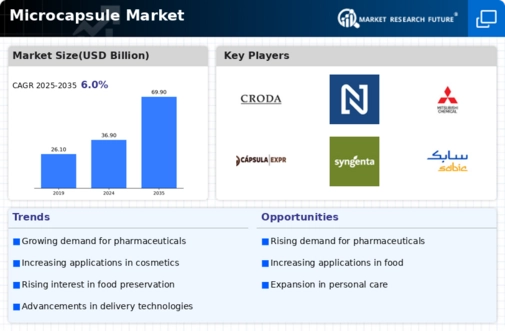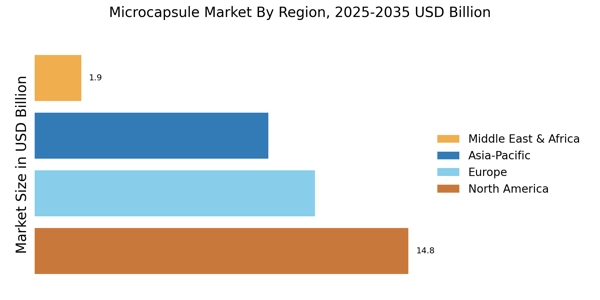The Microcapsule Market is currently characterized by a dynamic competitive landscape, driven by innovation, sustainability, and strategic partnerships. Key players such as BASF SE (Germany), Evonik Industries AG (Germany), and Givaudan SA (Switzerland) are actively shaping the market through their distinct operational focuses. BASF SE (Germany) emphasizes innovation in product development, particularly in the food and pharmaceutical sectors, while Evonik Industries AG (Germany) is leveraging its expertise in specialty chemicals to enhance microencapsulation technologies. Givaudan SA (Switzerland), on the other hand, is concentrating on expanding its flavor and fragrance offerings through advanced microencapsulation techniques, thereby enhancing product stability and release profiles. Collectively, these strategies indicate a trend towards more sophisticated applications of microencapsulation, which is likely to intensify competition in the market.
In terms of business tactics, companies are increasingly localizing manufacturing to reduce lead times and optimize supply chains. This approach appears to be particularly relevant in a moderately fragmented market where agility can provide a competitive edge. The collective influence of key players, including Clariant AG (Switzerland) and Nouryon (Netherlands), further underscores the importance of strategic positioning. Clariant AG (Switzerland) has been focusing on sustainable practices, which not only align with global environmental goals but also resonate with consumer preferences, thereby enhancing its market presence.
In August 2025, BASF SE (Germany) announced a strategic partnership with a leading pharmaceutical company to develop microencapsulated drug delivery systems. This collaboration is poised to enhance the efficacy and safety of medications, reflecting a growing trend towards personalized medicine. The strategic importance of this partnership lies in its potential to position BASF as a frontrunner in the pharmaceutical microencapsulation sector, thereby expanding its market share and reinforcing its commitment to innovation.
In September 2025, Evonik Industries AG (Germany) launched a new line of microcapsules designed for the agricultural sector, aimed at improving the efficiency of pesticide delivery. This initiative not only demonstrates Evonik's commitment to sustainability but also highlights the increasing demand for environmentally friendly agricultural solutions. The strategic significance of this launch is multifaceted; it not only addresses regulatory pressures but also aligns with the growing consumer demand for sustainable farming practices.
In July 2025, Givaudan SA (Switzerland) expanded its microencapsulation capabilities by acquiring a technology firm specializing in flavor microencapsulation. This acquisition is likely to enhance Givaudan's product offerings and strengthen its competitive position in the flavor and fragrance market. The strategic importance of this move lies in its potential to accelerate innovation and improve product differentiation, which is crucial in a market where consumer preferences are rapidly evolving.
As of October 2025, the Microcapsule Market is witnessing trends that emphasize digitalization, sustainability, and the integration of artificial intelligence in production processes. Strategic alliances are increasingly shaping the competitive landscape, enabling companies to leverage complementary strengths and enhance their market offerings. Looking ahead, it appears that competitive differentiation will evolve from traditional price-based competition to a focus on innovation, technological advancements, and supply chain reliability. This shift suggests that companies that prioritize these aspects are likely to gain a competitive advantage in the increasingly complex microcapsule market.


















Leave a Comment